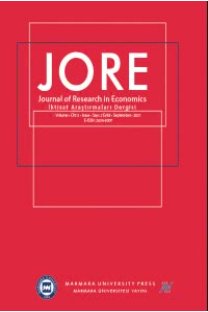OPTIMAL SIZE OF TURKIYE’S GROWING CITY: TEKİRDAĞ
OPTIMAL SIZE OF TURKIYE’S GROWING CITY: TEKİRDAĞ
Population, Happiness Degree Model Tekirdağ,
___
- Castells-Quintana, D., Royuela, V. and Veneri, P. (2020). Inequality and City Size: An Analysis for OECD Functional Urban Areas. Pap Reg Sci. 99:1045–1064. https://doi.org/10.1111/pirs.12520
- Choi,I. (2017). The optimum size of Seoul’s districts in South Korea, Journal of Public Affairs Volume 17 Number 3 e1617, 1-4. https://doi.org/10.1002/pa.1617
- Feng, W., Li B, Chen, Z. and Liu, P. (2021) City Size Based Scaling of the Urban Internal Nodes Layout. PLoS ONE 16(4): e0250348. https://doi.org/10.1371/journal.pone.0250348
- Frick, S.A. and Rodriguez-Pose, A. (2018). Big or Small Cities? On City Size and Economic Growth. Growth and Change, Vol. 49 No. 1, 4–32. https://doi.org/10.1111/grow.12232
- Jie, Z. and Yang, X. (2017). Optimal City Size in China: An Extended Empirical Study from the Perspective of Energy Consumption, Theme Documents, China City Planning Review, Vol. 26, No. 2, 22-28.
- Kong, Y. (2022). Correlation Analysis Between Financial Development Level and City Size Based on Mutual Information Algorithm. Mathematical Problems in Engineering, Volume 2022, 1-9. https://doi. org/10.1155/2022/4034176
- Lengths of State And Provincial Roads According To Surface Types By Provinces Statistics (Km.). Accessed by 01.07.2023. https://www.kgm.gov.tr/sitecollectiondocuments/kgmdocuments/istatistikler/ devletilyolenvanter/illeregoredevletveilyollari.pdf
- Li, L., Lei, Y., Wu, S., He, C., Chen, J. And Yan, D. (2018). Impacts of City Size Change and Industrial Structure Change on CO2 Emissions in Chinese Cities. Journal of Cleaner Production, 195, 831- 838. https://doi.org/10.1016/j.jclepro.2018.05.208
- Lianos, T.P., Pseiridis, A. (2016). Sustainable Welfare and Optimum Population Size. Environ Dev Sustain, 18, 1679–1699. https://doi.org/10.1007/s10668.015.9711-5
- Population Reference Bureau, Urban Population to Become the New Majority Worldwide (2007). Accessed by 01.07.2023, https://www.prb.org/resources/urban-population-to-become-the-newmajority- worldwide/#:~:text=The%203.3%20billion%20global%20urban,of%20the%20urban%20 population%20increase.
- Shi L., Li, D. and Zhao A. (2010). Method to Estimate Urban Optimum Population Conditions: A Case Study of Xiamen, China. J. International Journal of Sustainable Development & World Ecology, Vol. 17, No. 4, 324–328. https://doi.org/10.1080/13504.509.2010.489636
- T.R. Official Statistics of the Ministry of Agriculture and Forestry, Report of Corine. (2018). Accessed by 01.07.2023. http://rip.ormansu.gov.tr/rip/AnaSayfa.aspx?sflang=tr
- TURKSTAT (2023). Provincial Indicators. Accessed by 01.07.2023. https://cip.tuik.gov.tr
- Unhabitat World Cities Report. (2022). https://unhabitat.org/sites/default/files/2022/06/wcr_2022.pdf
- United Nations Report. (2017). Accessed by 01.07.2023 https://www.un.org/uk/desa/68-world-populationprojected- live-urban-areas-2050-says-un
- ISSN: 2636-8307
- Başlangıç: 2016
- Yayıncı: Marmara Üniversitesi
OPTIMAL SIZE OF TURKIYE’S GROWING CITY: TEKİRDAĞ
Onyebuchi Henry CHİOGOR, Gylych JELILOV, Olugbenga Omotayo ALABI
THE UNEXPECTED SHORTFALL: AN ALTERNATIVE RISK MEASURE
Tamerlan MASHADİHASANLİ, Haluk ZÜLFİKAR
INFLATION AND MONTHLY STOCK RETURNS RELATIONSHIP IN THE AIRLINE MARKET
